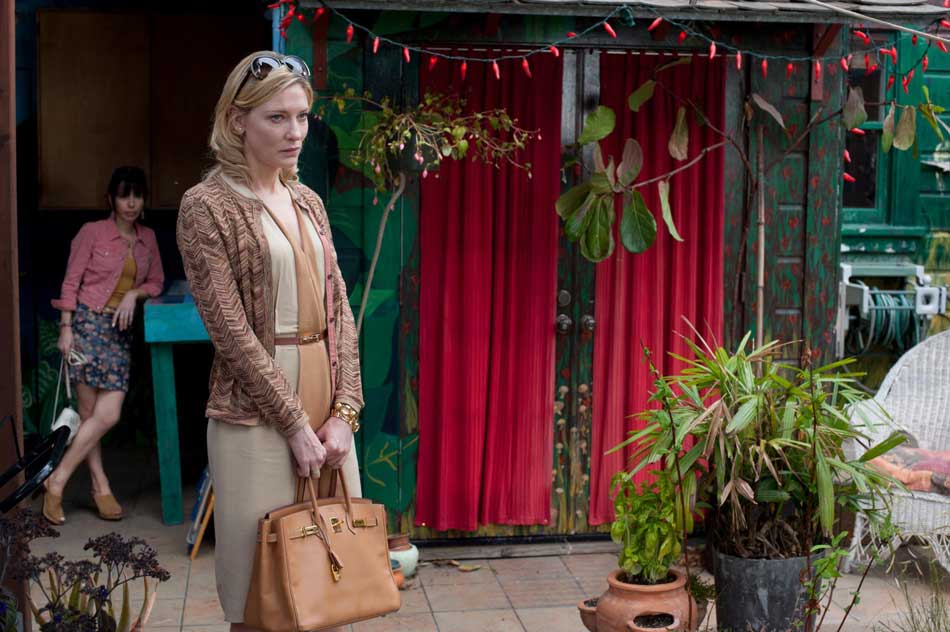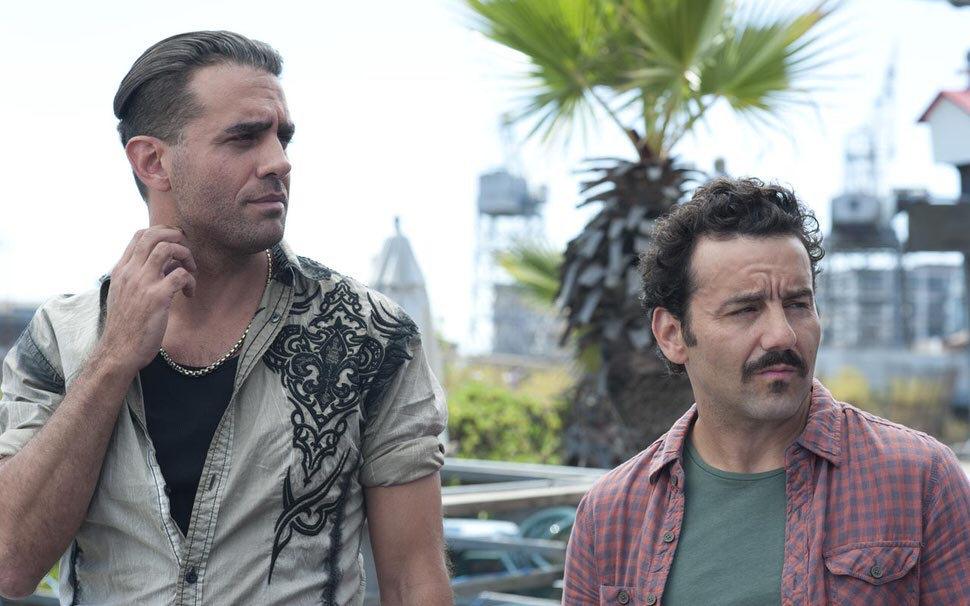Lingering in the lobby after watching Blue Jasmine, I overheard lots of praise for the film’s actors—but none of the wild admiration that the film itself has elicited from critics. The New York Times’s Manohla Dargis applauded Woody Allen’s “most sustained, satisfying and resonant film since Match Point,” and David Thomson, in The New Republic, called it “the best film that (Allen) has ever made.” But as far as I could tell, many audience members seemed, like me, uncomfortable and perplexed, disappointed in our hope that the film would be as smart, as engrossing, and visually beautiful as Match Point (2005) and Vicky Cristina Barcelona (2008).
Cate Blanchett plays the lovely Jasmine as a snob, entitled by social position and by the sort of beauty that makes her look as if she’d been born to wear Chanel; we’re repeatedly reminded that she’s changed her name from the more pedestrian Jeanette. She is the former wife and now the widow of a wealthy New York financier and swindler (Alec Baldwin) who, like Bernard Madoff, lost his entire fortune and a great deal of other people’s money. Impoverished, barely recovered from a nervous breakdown, Jasmine has crammed her last possessions into her Louis Vuitton luggage and flown first-class to San Francisco, to throw herself on the mercy of her working-class sister Ginger (Sally Hawkins). Divorced, the mother of two young sons, Ginger is about to settle down with her boyfriend Chili (Bobby Cannavale) when their plans are disrupted by the most toxic houseguest since Blanche DuBois showed up at the Kowalski apartment in Tennessee Williams’s A Streetcar Named Desire. Fascinated and appalled, we watch Jasmine’s deterioration accelerate until she is reduced to a mumbling street crazy, still wearing Chanel.
Blanchett’s performance is so riveting, and the film is so entertaining, that it took me until the next day to figure out why I’d found Blue Jasmine distasteful. That morning, my husband said he’d awoken in the middle of the night feeling as if we’d watched a film in which a woman is beaten, degraded, humiliated, tortured—a snuff film whose victim is driven mad but allowed to live.
I’ve always had a certain fondness for films about women breaking down, perhaps because madness has always seemed to me the road not taken. But none of the films I’ve admired—Nunnally Johnson’s The Three Faces of Eve (1957), John Cassavetes’s A Woman Under the Influence (1974), Pedro Almodóvar’s Women on the Verge of a Nervous Breakdown (1988), and most recently, Mike Leigh’s Another Year (2010)—have made me feel, as Blue Jasmine did, that the heroine is at least partly responsible and is getting what she deserves.
Only the force of Blanchett’s acting lifts Jasmine above the range of the potshots that Allen takes at her, starting with the opening scenes of her over-sharing with a woman on the plane and bossing a San Francisco cabdriver like her personal chauffeur. I could never quite tell when Allen was mocking or pitying Jasmine for her imperiousness, her narcissism, her rich woman’s values, her remaining illusions of self-worth. He makes us want to see the deluded snob lower herself and take the job she’s been resisting, as the receptionist of a creepy, sexually-harassing dentist—a job in which Allen, like most of us, might suffer. And just in case any doubts remain about whether Jasmine knew about her husband’s crimes, a somewhat improbable plot twist gives her an active—but surely superfluous—role in their being ejected like rebel angels from their Upper East Side heaven.
What makes us sympathize with a character is the director’s sympathy, the respect that inspires an artist to portray a dimensional human being. And it helps if even one other person on screen–Jim Broadbent and Ruth Sheen as the friends in Another Year, Peter Falk as the husband in Woman Under the Influence—genuinely cares about the troubled woman and wants her to recover. Here, only Ginger (marvelously portrayed by Hawkins) loves Jasmine, but she is still furious at her sister for having suggested that Hal invest—and lose—all of Ginger’s money. And it seems likely that the main reason Ginger wants Jasmine to regain her footing is that it will enable her to move out.
The only honest and intelligent man in Blue Jasmine is the squeaky clean, well-dressed Dwight (Peter Sarsgaard), whom Jasmine meets in San Francisco and who courts her until he discovers (as we expect and even guiltily hope he will) that she is a pathological liar. We may feel that Dwight is withholding some crucial information of his own; for example, the fact that his salary—he works for the State Department in Vienna—could hardly have paid for luxurious waterfront house he has bought in Marin County. But it hardly matters. The film’s male characters exist mainly to take turns giving Jasmine a series of gentle shoves toward the abyss.
Advertisement
How many hours have I spent in the dark, trying to like the films of Woody Allen? Part of what’s so disappointing about Blue Jasmine is that I so admired Match Point and Vicky Cristina Barcelona. I loved the Hitchcock-like suspense and rhythms of Match Point, the sunny pleasure that Vicky Cristina Barcelona took in a beautiful city and beautiful faces. The performances were thrilling. I was so impressed by those films that I was willing to give Allen a pass on Midnight in Paris (2011), with its freshman-undergraduate take on the Left Bank in the 1920s, and the frothy travelogue that was To Rome with Love (2012). I like looking at pictures of Rome!
But thinking about Blue Jasmine reminded me of what I’d found disturbing about Allen’s earlier films: Annie Hall (1977), Manhattan (1979), Stardust Memories (1980), and Celebrity (1998). The misanthropy and misogyny; the meanness masquerading as humor; the thick air of condescension; the sourness and crabbed resentment. The suspicion that the characters are acting out the director’s agenda, just as the actors, until lately, sometimes spoke in his rhythm, his voice. Another pleasure of Match Point was the relief (for the viewer, and, I would think, for Allen) occasioned by the fact that Allen had not only removed himself as a dramatic character but also as a dominant presence.
Many of Allen’s films have featured women fighting over a man, battles predictably won by the younger actress with the nicer skin. Celebrity pitted a luminous Winona Ryder against the attractive Judy Davis, cruelly lit to diminish her beauty and accentuate her age. Vicky Cristina Barcelona finally found a trio—Rebecca Hall, Scarlett Johansson, and Penelope Cruz—of equally matched rivals to engage in a contest in which Cruz prevailed by being not only beautiful but so irresistibly funny and manic that she all but erased her opponents from the screen.
In Blue Jasmine, the odds are once again stacked against the loser, the struggle this time being between a character and her creator. I didn’t feel as if were watching a woman being tortured so much as a woman being drowned. And I couldn’t help thinking that I’d been manipulated by plot turns, dialogue, and cinematography until a part of me wanted to see Jasmine’s head pushed back under water.
I’ve reread Manohla Dargis and David Thomson, whose criticism I respect. I’ve been trying to figure out how we could have seen such different movies. Was there something I missed? A friend says it’s a great mistake to expect Woody Allen’s movies to be realistic because they are all fairy tales of a sort, fantasies in which actors are given the freedom to work at the height of their powers, to invent, to outdo themselves and to pretend to be people—or make-believe people. Don’t ask for more—or less.
And yet Blue Jasmine made me feel much the same discomfort I experienced when I finally read Gillian Flynn’s Gone Girl, which has been on The New York Times bestseller list for over a year, a novel steeped in a foul, bitter stew of treachery, vengefulness, and scheming—a book that millions of Americans have been telling their friends to read, presumably for its suspense and all-too-foreseeable “surprises” as a dishonest marriage devolves into a plan to frame a spouse for murder. I prefer not to think that we live in a culture in which nastiness is so endemic that we can no longer recognize it. Unless in fact we do, and, like the ancient Romans at the Colosseum, we’re grateful for the distractions of socially sanctioned cruelty and the gladiatorial combat of the strong against the weak.



